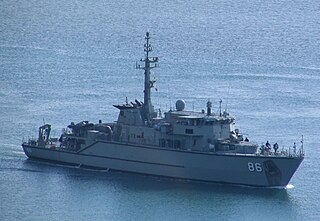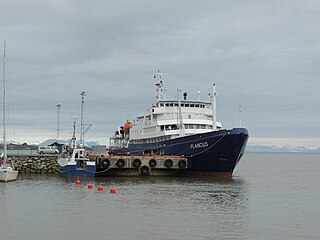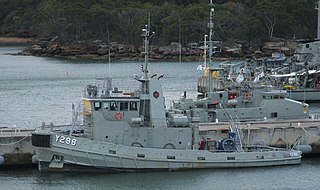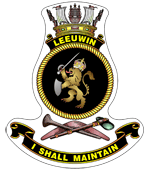
HMAS Parramatta is an Anzac-class frigate of the Royal Australian Navy (RAN). One of ten warships built for the RAN and Royal New Zealand Navy (RNZN) based on the MEKO 200 design, Parramatta was laid down in 1999, launched in 2003, and commissioned into the RAN in 2003. During her career, the frigate has been deployed to the Middle East on several occasions. In early 2015, Parramatta was docked to undergo the Anti-Ship Missile Defence (ASMD) upgrade. She completed these upgrades in April 2016.

HMAS Toowoomba is the seventh Anzac-class frigate of the Royal Australian Navy (RAN). She was laid down in 2002 by Tenix Defence and commissioned in 2005.

The Huon-class minehunter coastal (MHC) ships are a group of minehunters built for the Royal Australian Navy (RAN). Following problems with the Bay-class minehunters, a request for tender was issued in 1993 for a class of six coastal minehunters under the project designation SEA 1555. The tender was awarded in 1994 to the partnership of Australian Defence Industries (ADI) and Intermarine SpA, which was offering a variant of the Italian Gaeta-class minehunter.

HMAS Huon, named for the Huon River, is the lead ship of the Huon class of minehunters operated by the Royal Australian Navy (RAN). The first of six ships built by a joint partnership of Australian Defence Industries (ADI) and Intermarine SpA, Huon's hull was fabricated at Intermarine's Italian shipyard, then freighted to ADI facilities at Newcastle for completion. She entered service in 1999.

The Pacific class is a class of 22 patrol boats built by Australia and donated to twelve South Pacific countries. They were constructed between 1985 and 1997 and are operated by militaries, coast guards or police forces of twelve island nations. These boats are supported by the Pacific Patrol Boat Program and used primarily for maritime surveillance and fisheries protection.

The Leeuwin class is a two-ship class of hydrographic survey vessels operated by the Royal Australian Navy (RAN). Leeuwin and Melville were ordered from NQEA Australia in 1996, and were commissioned in 2000. The ships are capable of charting waters up to 6,000 metres (20,000 ft) deep, carry three Fantome-class survey boats, and could operate an AS 350B Squirrel helicopter. In addition to surveying duties, since 2001 both vessels have been used to supplement the RAN patrol force. Leeuwin and Melville are based at HMAS Cairns, and are active as of 2023.

HMAS Diamantina, named after the Diamantina River, is a Huon-class minehunter currently serving in the Royal Australian Navy (RAN). Built by a joint partnership between Australian Defence Industries (ADI) and Intermarine SpA, Diamantina was constructed at ADI's Newcastle shipyard, and entered service in 2000.

HMAS Melville is the second ship of the Leeuwin class of hydrographic survey vessels operated by the Royal Australian Navy (RAN).

HMAS Norman, named for the Norman River in Queensland, is the third Huon-class minehunter to serve in the Royal Australian Navy (RAN). Built by a joint partnership between Australian Defence Industries (ADI) and Intermarine SpA, Norman was constructed at ADI's Newcastle shipyard, and entered service in 2000.

Godetia (A960) was a command and logistical support ship of the Belgian Naval Component, launched on 7 December 1965 at the Boelwerf in Temse and entered service on 2 June 1966. The patronage of Godetia was accepted by the city of Ostend. She was the first of two support ships acquired to replace World War II-era ships. Used primarily to provide logistic support to Belgium's fleet of minesweepers, Godetia has also seen service as a training ship, royal yacht and fisheries protection. The vessel has served with NATO's Standing NATO Mine Countermeasures Group 1 in the Baltic and North seas. In June 2021, Godetia was taken out of service.

HMAS Gascoyne, named for the Gascoyne River, is the fourth of six Huon-class minehunters constructed for and currently in service with the Royal Australian Navy (RAN). Built by a joint partnership between Australian Defence Industries (ADI) and Intermarine SpA, Gascoyne was constructed at ADI's Newcastle shipyard, and entered service in 2000.

HMAS Hawkesbury, named for the Hawkesbury River, is the second Huon-class minehunter to have been built for the Royal Australian Navy (RAN). Built by a joint partnership between Australian Defence Industries (ADI) and Intermarine SpA, Hawkesbury was constructed at ADI's Newcastle shipyard, and entered service in 2000.

HMAS Yarra is the sixth Huon-class minehunter to have been built for the Royal Australian Navy (RAN) and the fourth warship to be named after the Yarra River in Victoria. Built by a joint partnership between Australian Defence Industries (ADI) and Intermarine SpA, Yarra was constructed at ADI's Newcastle shipyard, and entered service in 2003.

The Paluma-class motor launch was a class of four hydrographic survey motor launches operated by the Royal Australian Navy (RAN). Built in Port Adelaide between 1988 and 1990, the four catamarans were primarily based at HMAS Cairns in Cairns, Queensland, and operated in pairs to survey the waters of northern Australia.

The Cheonghaejin class is a submarine rescue ship class of the Republic of Korea Navy. Only one ship has been built in the class, ROKS Cheonghaejin, in 1995. Its operations include rescuing trapped sailors in submarines, naval operation support for submarines, underwater research and mapping support, and recovery of sunk vessels. It is equipped with a deep submergence rescue vehicle (DSRV) that operates up to 500 metres (1,600 ft), and a rescue chamber that holds up to nine people.

The Fantome class is a class of eight small survey motor boats (SMBs) operated by the Royal Australian Navy (RAN) and DMS Maritime. The four-man boats are designed to operate from the Leeuwin-class survey vessels, with three assigned to each ship, while the seventh and eighth were attached to the RAN Hydrographic School at HMAS Penguin. They are fitted with navigational and survey equipment and are unarmed.

The Antarctic Survey Vessel (ASV) Wyatt Earp is a survey launch operated by the Australian Hydrographic Service since 1993. Based on the Royal Australian Navy's Fantome-class survey launches, Wyatt Earp was built specifically for hydrographic survey duties in Antarctic waters.

MV Plancius, formerly HNLMS Tydeman (A906), is a renovated oceanographic research vessel of the Royal Netherlands Navy now employed as a polar expedition cruise vessel by owner and operator Oceanwide Expeditions. She was commissioned into the Royal Netherlands Navy on 10 November 1976, and served until 2004, before being renovated for commercial use. The vessel was used for both military and civilian research and had a fracture zone named after it.

The Craft of Opportunity Program (COOP) was a Royal Australian Navy (RAN) acquisition program intended to supplement the navy's mine warfare capability with civilian vessels that could be quickly converted into minesweepers. Vessels acquired under COOP were not commissioned into the RAN, and instead operated with the prefix "MSA" (Minesweeper Auxiliary).

The Bandicoot class was a ship class of two minesweeper tugboats operated by the Royal Australian Navy (RAN). MSA Bandicoot and MSA Wallaroo were built in 1982 for Maritime (PTE) Ltd. as the tugboats Grenville VII and Grenville V. In 1990, the RAN purchased the vessels for conversion into auxiliary minesweepers under the Craft of Opportunity Program (COOP). The vessels could be equipped with a sidescan sonar and various towed minesweeping arrays, and also functioned as berthing tugs. Both vessels were placed in reserve in 2010, but were deployed on several occasions since to provide berthing support to nuclear-powered warships. They were removed from naval service in 2014.





















